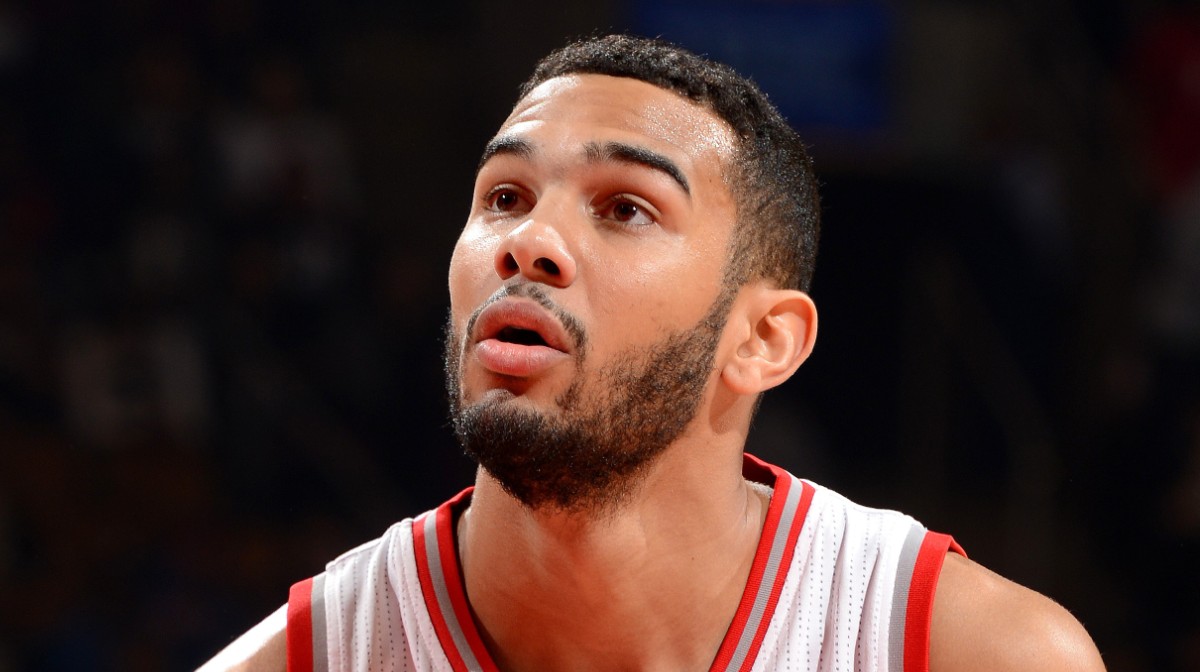You can keep up with all of our player previews here.
Remember that one song every now and then that you could listen to anytime you felt down? Perhaps you were sad, annoyed, confused, angry, or just needed a pick-me-up before a big game. There was always that tune at the time that had the ability to get you back up and fired up.
At least in my eyes, Cory Joseph was that tune for the Raptors for most of the games last season. Though he had his fair share of ups and downs, CoJo was, for the most part, a solid backup, who passed all the major eye tests. The defense (and every night, the effort) was certainly there; the ability to get to the rim, the efficient and smart shooting, as well as a steady handle at the point were all features of Joseph’s first year as a Raptor. And let’s not forget – that was a pleasant surprise.
Just more than a year ago, Cory Joseph shouldered the burden of a relatively large (at the time) 4-year $30 million contract to live up to, based on solely forward-looking projections, rather than any sort of solid historical data. Save for disciplined opportunistic play on a very good team during his time in San Antonio, while Joseph had the blueprint of a smart player that was ready to take the next step, it’s not like the Raptors were rewarding him for stand out play – they took a pretty reasonable bet, and it paid off very well. The value of a $7.5M a year contract for a grade-A backup in today’s NBA absolutely can’t be undermined. Just another example of a shrewd “splash” (at least for his standards) made by Masai Ujiri.
While Cory certainly may have passed the eye tests, his true value is better viewed through the lens of basic efficiency metrics.
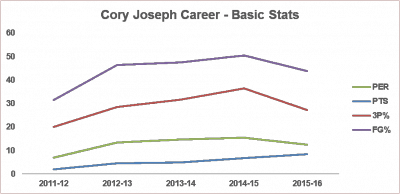
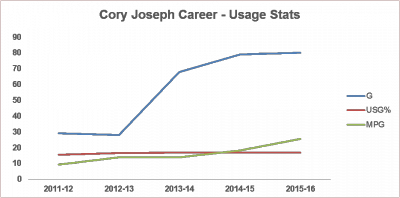
Strengths and things to continue doing
- Efficiency: Cory shot above 45% for most of the season last year, before tailing off in the final set of contests and ending the season around 44%. Joseph’s efficiency has been better in the past, but given the drastically higher games and minutes per game played in the 15/16 campaign as compared to his past seasons, the efficiency was remarkably reliable on most nights, with Joseph’s shot selection being the most impressive factor. Shots at the elbow areas were Cory’s favourite, mostly off the Patterson/Biyombo screen, which this year will translate to screens from Sullinger/Patterson or even Bebe/Poertl on occasion. Setting solid screens and giving Cory space should mean a green light if he’s got his feet set and is in his sweet spots.
Cory Joseph – 2015/2016 Shot Chart
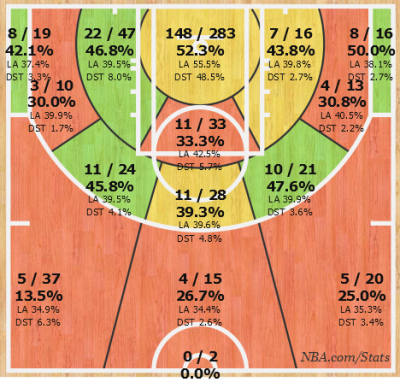
- Ball protection: With an increased assist level of 3.1, up from 2.4 the previous year, increased turnovers were expected, but Joseph’s average of just around 1.3 a game was still impressive considering he was often given the job of anchoring the team’s offense when Lowry was either resting or playing off the ball. Joseph’s uncanny ability to protect the rock, or finish around the rim even under the most difficult of circumstances was something we grew to love every night.
- Defensive toughness and versatility: While this was pretty much expected from Joseph, the lack of a significant historical body of data to draw from made it difficult to predict just how impactful his defense could be at the beginning of last season. But on most nights, he proved he could check not only the best point guard on the floor, but also shooting guards. Joseph’s defensive rating of 108 per 100 possessions, was a slight regression from the previous season at 104, likely due to a heavier usage and on most nights, against first-string talent. But Joseph’s ability to fight through screens, stay with his man laterally, and challenge shots all the way to the hoop was impressive.
Weaknesses and things to improve upon
- Three point shooting: Even though Cory might have continued the DC heartbreak tradition hitting a dagger 3 to sink the Washington Wizards back in November of last year, his three-point shooting was something that was timely, but needed improvement from a consistency perspective. Cory attempted 66 more three pointers last year (110) than the season before (44), but only hit 14 more of them. That translated to a percentage regression from 36% to 27%, meaning Cory was good when needed, but when counted upon consistently and against better competition, the shooting just wasn’t there. Not to mention, when they were falling, they were generally from the same spots (Cory shot a very respectable 46% combined from the corners, but a dismal 19% elsewhere beyond the arc). I’d still like to see his three-point shot chart spread out, and with a combined percentage at least in the 33-35% range. Cory discussed working on his three-point shooting during his media day availability last week:
Cory Joseph – 2015/2016 3-Point Shot Chart
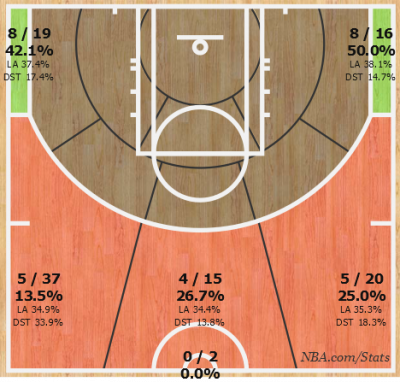
- Shooting aggressively: While it might sound ludicrous to praise Joseph’s efficiency and then list his shooting as a weakness, it’s not just the ability to shoot and make shots, it’s also the drive to continue shooting and be opportunistic with what the defense gives you. This means increasing range and efficiency across the floor, and using screens effectively to make shots. Cory isn’t exactly a pure point guard, as he’s shown the ability to play the shooting guard position as well as defend it. So as Lowry takes charge of the offense when Coach Casey goes with the Lowry/Joseph combo in the backcourt, Cory’s got to continue pounding the ball inside on takes to the rim, as well as increase his effectiveness at the long 2’s (he shot just 40.1% on these attempts last year).
Player prediction
I was going to refrain from a player prediction since I wanted to reserve my often incredibly wrong predictions for the actual games this season, but nonetheless I took a stab at trying to predict what this guy can bring to the table this year.
Even though I expect a more polished offensive game from Joseph for the reasons noted above, I also expect some finer details that will contribute to some regression as well. For instance, Biyombo’s screen setting and rolling to the rim won’t be available anymore – something Joseph learned to feed off of increasingly effectively toward the tail end of last season. Further, I anticipate Delon Wright (who I’ll be previewing next week) will figure into the rotation at least a tad more this season after he returns from injury (not saying Wright’s going to be our second stringer, just that an opening or opportunity could mean playing time which could showcase his ability), meaning some of Joseph’s minutes could be up for grabs. Not to mention, Cory had almost no injury concerns last year, playing 80 games and without any significant damage to any part of his body. Not to sound negative, but generally speaking, that kind of luck doesn’t usually continue for multiple seasons at the point guard position, meaning at least a small degree of injury should be expected.
Having said all of that, I expect Cory to continue to be one of the leaders of this team’s second unit, with points per game in the 10-11 range, and assists in the 3.5 – 4 apg range. In a best-case scenario, he can keep his turnovers to under 1.5 a game, and increase his field goal and three point efficiency to be above 45% and 35% respectively. While the field goal percentage is hard to predict, I think it’s safe to assume the three-point shooting will be at least marginally better at just under or around 35%.
One thing’s for certain though – Cory Joseph, who’ll be entering the second year of his ultra-valuable contract, will prove himself to be an invaluable asset for this team, as a reliable second string point guard, hopefully an improved offensive scorer, and a defensively-capable secondary punch next to Lowry in small-ball lineups. For all that and more – it’s CoJo for life.


